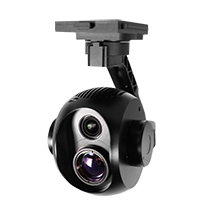Drone Gimbal , Parts and Top Gimbals for Aerial Filming Leave a comment
Having a top quality drone gimbal is essential to capturing great aerial film, photography, 3D mapping, lidar, photogrammetry and other sensor driven imagery.
For drones to be widely used across different sectors, it is essential that UAV gimbal stabilization technology keeps in line with drone innovation. This is very much the case so far.
Here is a quick overview of the design and workings of a drone gimbal and the gimbal components. With this knowledge you will be able to choose the best drone gimbal for your aerial cinematography.
Knowing the aerial gimbal components will help you if you need to troubleshoot any gimbal issues.
From 3-axis brushless motors, Gimbal Control Units (GCU), IMU and anti-vibration systems, you will find plenty of very useful knowledge below.
We also take a look at the best aerial gimbals available, along with the drones they can be mounted on. You will also find some excellent drone gimbal videos along the way.
Now, when it comes to drone gimbal innovation, we are finding that the 3rd party manufacturers of cameras and sensors (lidar, thermal, ultrasound etc) are playing catch up with the drone and gimbal innovation to date.
Drone manufacturers such as DJI, Yuneec and Walkera are not waiting around and have filled this gap by producing their own integrated gimbal / cameras.
DJI, Walkera and Yuneec have also partnered with Flir to allow thermal vision sensors to be mounted on their drones.
The latest top drones have almost perfect flight and gimbal stability even in very blustery conditions. This flight and gimbal stabilization is the result of big improvements in all drone components including the software controlling these components.
Also, most quality drones today all have 4k cameras including a multitude of camera settings to capture superb aerial shots in all lighting conditions.
What Is A Drone Gimbal Answered?
A gimbal whether handheld or mounted on a drone is designed to give the camera operator the independence of photographing or filming without camera vibration or shake.
Generally powered by three brushless motors (3-axis), the gimbal has the ability to keep the camera level on all axes (pan, roll, tilt) as the operator moves the camera. An inertial measurement unit (IMU) responds to movement and utilizes its three separate motors to stabilize the camera.
With the guidance of algorithms, the stabilizer is able to notice the difference between deliberate movement such as pans and tracking shots from unwanted shake. This allows the camera to seem as if it is floating through the air.
Total Control Aerial Filming Platforms
Drone flight control systems and aerial gimbal innovation has moved swiftly over the past 2 years. Just a few short years ago, you had very little control of the camera mounted on a drone. You would have to switch on the camera and set it to record before take off. You had no control of the gimbal or camera after take off.
Not any more. Practically all the latest drones have the gimbal and camera integrated into the flight control system and can easily be controlled by the remote control ground station. You now have first person view along with live video downlink which can also be streamed straight to YouTube.
Parts Of A Drone Gimbal
This below drawing is of the DJI Zenmuse Z15-5D III (HD) gimbal and is suitable for the Canon 5D Mark III camera. Most aerial gimbals are similar so this Zenmuse Z15 so if you understand these components you will know your way around most UAV gimbals on the market.
2 or 3-Axis Drone Gimbal
3-axis gimbals provide better video stability than 2-axis gimbals. This is because 3-axis gimbals stabilize your video on all 3 axis (yaw, pitch and roll) while a 2-axis gimbal will stabilize only on the pitch and roll axis.
Jittery horizontal, jello or rolling shutter movement, is more obvious in videos taken using a 2-axis gimbal due to the lack of stabilization in the yaw axis.
3-axis gimbals are able to greatly reduce and sometimes completely eliminate jello due to the third motor, which helps absorb unwanted movement in the yaw axis. However, 3-axis gimbals are heavier and more expensive than their 2-axis counterparts. They also draw more battery power due to having more motors.
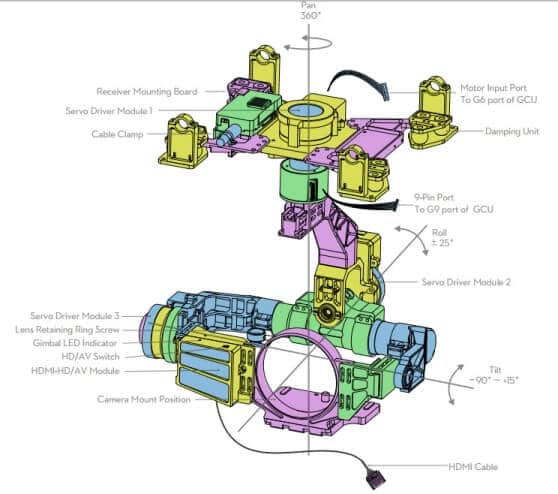
Gimbal Brushless Motors And Angles
3 x Servo Driver Modules (Pan, Roll, Tilt) to power the gimbal. Most drones gimbals components including the motors are designed for a particular camera or sensor.
This design method achieves almost perfect filming because the gimbal has been fine-tuned to the weight and balance of the individual camera.
Almost all drone gimbals today are powered today by brushless motors. At the very basics of motor design, the difference between a brushed and brushless is a dead giveaway.
Brushless motors lack brushes. However, their design differences are a bit more sophisticated. A brushless motor mounts its permanent magnets, usually four or more, around the perimeter of the rotor in a cross pattern.
Efficiency is a primary selling feature for brushless motors. Because the rotor is the sole bearer of the magnets, it requires no power, i.e., no connections, no commutator, and no brushes. In place of these, the motor employs control circuitry.
Drone Gimbal Axis Movements
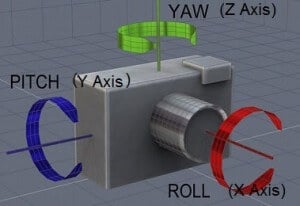
Pan (Yaw): A yaw motion is a lateral side to side movement of the gimbal / camera to the left or right. Most drone gimbals have 360 degree movement.
If you have a drone with retractable arms, then you have a full 360 degree of unobstructed views. The DJI Inspire 1 and Walkera Voyager 3 drones have retractable arms.
Roll: A positive roll angle lifts the gimbal / camera to the left or right. The Zenmuse Z15 above has a +-15 degrees of roll movement.
Tilt (Pitch): An up and down movement of the gimbal and camera. In the above gimbal diagram we can see this has a -90 to +15 degree of movement.
Top Aerial Cinematography Angles
Our modern drones fly on all 3 axis. Together with the ability to control the drone gimbal and camera on all 3 axis, we now have total control over our aerial cinematography views. In just a few years, the latest flight control systems along with excellent stabilized gimbals has gave us perfect aerial film quality.
Damping Anti-Vibration Absorber
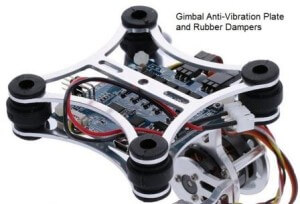
These units have the very important function of reducing or damping the medium to high vibration frequencies from the drone reaching the camera while still allowing low frequency actual board movement to take place in conjunction with the drone frame.
Some DIY anti-vibration dampers are made from foam, rubber balls and even ear plugs.
However, these are a very vital piece of equipment and don’t cost a lot of money so it is probably a good idea to have the best dampers you can afford.
A professionally made gimbal damper will be made with carbon fiber with anti-vibration plate with 4 rubber balls specifically designed for the gimbal.
Drone Gimbal IMU
Most drone gimbals including the Zenmuse Z15 above have an inbuilt IMU (inertial measurement unit). This Zenmuse also has an extra inbuilt infrared module. The gimbal IMU uses programmed algorithms which create almost total stabilization and give effortless control to the operator.
Because the IMU is built in, your gimbal requires no extra equipment or wiring while reducing weight and allowing you to start capturing film faster. The shutter can be controlled remotely by an infrared receiver.
The IMU can be misaligned over time or even straight out the box. With the correct angle of view, the camera should film the horizon with a straight line. When it is misaligned, you can have horizon tilt problems. There are a number of ways to fix this including calibrating the gimbal and drone IMU.
Taking a step back, an IMU (inertial measurement unit) is an electronic device which measures and reports a body’s specific force, angular rate and sometimes the magnetic field surrounding the body, using a combination of accelerometers and gyroscopes, sometimes also magnetometers.
In this capacity, the data collected from the IMU sensors allows a computer to track the UAV or aircraft’s position.
Drone Gimbal Control Unit (GCU)
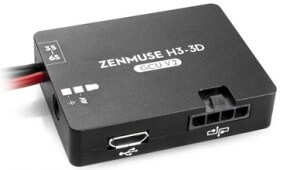
The Gimbal Control Unit also referred to as a GCU, is essentially a simple computer that takes data from the gyros and responds by telling the gimbal motors which way to move.
The GCU module connects and communicates with the Flight Control System to help control the gimbal. At the same time, it outputs video information to the video downlink for video transmission.
Examples of Flight Control Systems are the DJI N3 and DJI A3 models and the Pixhawk autopilot from 3DR.
Cameras and Sensors
All the above mentioned parts are no good without the camera or sensor to capture the aerial photography, film or 3D imagery. The gimbal should come with the correct mounts, screws and cables to connect the camera to the gimbal and control unit.
Supporting Components For Gimbal / Camera
Devices such as the IOSD Mark II have an built-in BEC module which supports 3S – 6S LiPo battery. It provides the power supply for the camera and the main controller, which improves the power supply reliability.
When devices such as the DJI IOSD MARK II are used in conjunction with the flight controllers, you will get an even better and more stable flying experience which means less vibration moving towards the gimbal and camera.
Top Drone Gimbals For Aerial Filming
When it comes to filming, the less vibration and camera shake the better. You then can capture the best video and still shots for the flight. Afterwards, back in the home or office, their is more work to do, whether it is editing the film or photos and packaging them into a video or catalog.
It is also true when it comes to creating 3D maps or 3D models of structures, the less vibration of the drone and camera is vital. Using a drone to fly autonomously taking hundreds or even thousands of photos of a land area or building structure needs serious software and computing power to stitch the photos together.
The software need to stitch hundred or even thousands of photos taken sequentially is called photogrammetry software. Some of the big names are DroneDeploy, Pix4Dmapper and Agisoft PhotoScan. You can read further on the best software to create 3D maps and models. The article has reviews along with videos on the market leaders in photogrammetry software.
